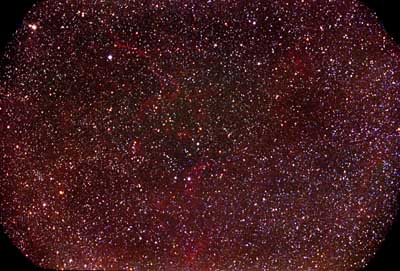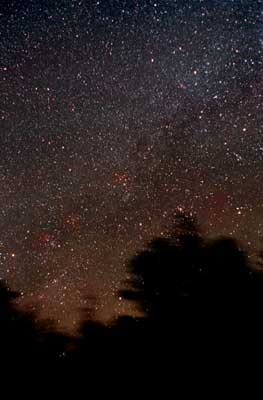|
How low can you go on your southern sky horizon? For my site up in Happy Jack Arizona, this set of images is one answer to that burning question. The upper image is a single 8 minute Schmidt camera exposure on Supra 400 looking at a point due south, just skimming the distant tree tops on the southern horizon. The field is filled with shreds of delicate nebulosity from the notoriously difficult to shoot Gum Nebula in Vela. At -44 declination, it is very low in the south, only theoretically 12 degrees up. Our sky is dark transparent all the way down to the horizon here, and only the dim airglow band around the horizon lights the scene. The bottom image was taken at the same time, also on Supra 400, and shows the cut in the distant trees that marks the meridian, and my southernmost viewing window. Numerous patches of dim red nebulosity fill the field of this 50mm wide angle shot covering Vela, and Pyxis. The Gum nebula is the two rosy patches of nebulosity to the lower left. The object just below center, and just above the tree to the lower right is too faint to show on my Megastar Atlas. Note the color gradation from the top to bottom of the frame. This yellow coloration near the horizon is atmospheric extinction, and yellows the light from the sky.
Instrument: 8" f/1.5 Celestron Schmidt Camera and 50mm f/2.8 Pentax Super Taukamar Lens Platform: Homemade GEM Film: Kodak Supra 400 CCD Autoguider: None Exposure: 2x8mins Filters: none Location: Happy Jack, Arizona Elevation: 6800 ft. Sky: Seeing 8/10, Transparency 10/10 Outside Temperature: -12 C Processing: Photoshop, PW Pro.
|
||||||
|
|
||||||
|
FastCounter by bCentral |

